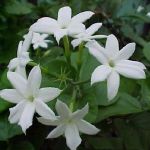| Common Name: |
Arabian Jasmine |
| Botanical Name: |
Jasminum sambac |
| Genus: |
Jasminum |
| Family: |
Oleaceae |
| Native Location: |
Probably in tropical Asia |
| Cultivation: |
Rich, well-drained soil in sun. Thin out shoots or cut back after flowering. Plants under cover may be affected by spider mite, aphids, whitefly, and mealy bugs. |
| Propagation: |
By semi-ripe cuttings in summer; by layering in autumn. Jasminum sambac "Grand Duke of Tuscany" is difficult from cuttings. |
| Harvest: |
Roots are lifted in autumn and dried for use in decoctions (J. sambac). Leaves are picked as required and used fresh or dried. Flowers are picked soon after opening each morning and used fresh for oil extraction, or dried for infusions, medicated oil, pastes and powders. |
| Varieties: |
Grand Duke of Tuscany syn. Trifoliatum
(Kudda-mulla, Tuscan jasmine)
Is slow growing, with leaves arranged in threes, and large, very double (occasionally fasciated) flowers.
Maid of Orleans syn. Flore Pleno
Has double flowers. |
| Height: |
1.5-2m (5-6ft) |
| Hardiness: |
Z9-10 |
| Parts Used: |
Roots, leaves, flowers. |
| Properties: |
Similar to J. officinale. Shown experimentally to lower blood pressure and inhibit milk production. |
| Medicinal Uses: |
Externally for ear and eye infections, indolent ulcers, and as a poultice to reduce milk flow. |
| Culinary Uses: |
Flowers are used to scent green (Hyson) tea (jasmine tea). Jasmine flower water is used to flavor desserts in SE Asia. |
| Economic Uses: |
Essential oil is used in commercial food flavoring and perfumery. |
| Bibliography: |
Encylopedia of Herbs by Deni Brown Copyright ©: 1995, 2001 Dorling Kindersley Limited pg 245-246
|
